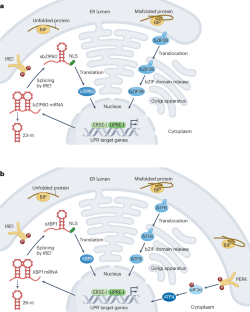Dynamics of ER stress-induced gene regulation in plants
IF 39.1
1区 生物学
Q1 GENETICS & HEREDITY
引用次数: 0
Abstract
Endoplasmic reticulum (ER) stress is a potentially lethal condition that is induced by the abnormal accumulation of unfolded or misfolded secretory proteins in the ER. In eukaryotes, ER stress is managed by the unfolded protein response (UPR) through a tightly regulated, yet highly dynamic, reprogramming of gene transcription. Although the core principles of the UPR are similar across eukaryotes, unique features of the plant UPR reflect the adaptability of plants to their ever-changing environments and the need to balance the demands of growth and development with the response to environmental stressors. The past decades have seen notable progress in understanding the mechanisms underlying ER stress sensing and signalling transduction pathways, implicating the UPR in the effects of physiological and induced ER stress on plant growth and crop yield. Facilitated by sequencing technologies and advances in genetic and genomic resources, recent efforts have driven the discovery of transcriptional regulators and elucidated the mechanisms that mediate the dynamic and precise gene regulation in response to ER stress at the systems level. Plants have uniquely adapted to manage endoplasmic reticulum stress triggered by protein misfolding. The authors review the dynamics of gene expression regulation underlying the unfolded protein response in plants, highlighting recent insights provided by systems-level approaches and omics data.


植物中ER胁迫诱导的基因调控动态。
内质网(ER)应激是由ER中未折叠或折叠错误的分泌蛋白的异常积累诱发的一种潜在致死状态。在真核生物中,ER 应激由未折叠蛋白反应(UPR)通过严格调控但高度动态的基因转录重编程来管理。虽然 UPR 的核心原理与真核生物相似,但植物 UPR 的独特性反映了植物对不断变化的环境的适应性,以及平衡生长和发育需求与环境胁迫响应的需要。过去几十年来,人们在了解ER胁迫感应和信号转导途径的基本机制方面取得了显著进展,UPR与生理性和诱导性ER胁迫对植物生长和作物产量的影响有关。在测序技术以及基因和基因组资源进步的推动下,最近的研究工作推动了转录调控因子的发现,并阐明了在系统水平上介导响应 ER 胁迫的动态和精确基因调控的机制。
本文章由计算机程序翻译,如有差异,请以英文原文为准。
求助全文
约1分钟内获得全文
求助全文
来源期刊

Nature Reviews Genetics
生物-遗传学
CiteScore
57.40
自引率
0.50%
发文量
113
审稿时长
6-12 weeks
期刊介绍:
At Nature Reviews Genetics, our goal is to be the leading source of reviews and commentaries for the scientific communities we serve. We are dedicated to publishing authoritative articles that are easily accessible to our readers. We believe in enhancing our articles with clear and understandable figures, tables, and other display items. Our aim is to provide an unparalleled service to authors, referees, and readers, and we are committed to maximizing the usefulness and impact of each article we publish.
Within our journal, we publish a range of content including Research Highlights, Comments, Reviews, and Perspectives that are relevant to geneticists and genomicists. With our broad scope, we ensure that the articles we publish reach the widest possible audience.
As part of the Nature Reviews portfolio of journals, we strive to uphold the high standards and reputation associated with this esteemed collection of publications.
 求助内容:
求助内容: 应助结果提醒方式:
应助结果提醒方式:


